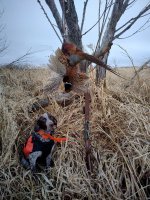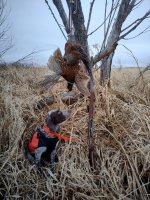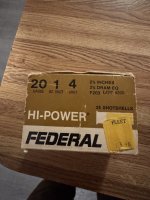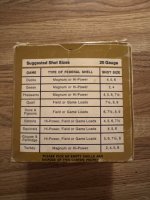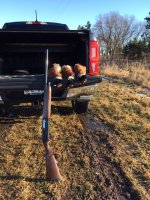December 27th, public land hunt, SC MN.
Rain in the cities, as we made our way south. Fog in outstate, but not a driving detriment -- until the evening, where I was in constant danger of outrunning my headlights. No rain once we got to the hunting spot, but I knew there was a chance of some around 2-4 pm. It was 41 deg, with an 8-10 mph wind out of the south.
I passed a couple guys older than me, down the road, across from a different hunk of public land. I assumed they were hunting the private land across from that parcel. Soon after I parked, they came up and parked next to me. The immediate sections of the place we were at is bisected by an access road in one direction and a creek in the other direction, providing 4 chunks for hunting. They asked if I was hunting in front of the vehicles or behind them. I said "yes", jokingly. Although, that had been my plan. I was going to hunt in front of the vehicles and then go kitty corner across the road and on the other side of the creek. I asked where they would like to hunt, and they said the smaller, easy walking area in front of the vehicles. I said I would hunt kitty corner behind us.
I had only hunted this chunk once this year. I think it was several days after opener. I had knocked one down in dry conditions that turned into a road runner, and never saw it again. We then went to a different access and bagged a couple. It might as well have been October, because the birds weren't interested in the wet, slushy ice cattails, and were out in wetland grasses and other cover. We did hear a clucker in the kitty corner chunk that is connected via a large thicket that is a pain to walk through, and I decided we would drive around to talk to him later. Honey chased down a runner over 100 yards away that I never saw flush, as I was fighting through some woody plants. A bird flushed when she came back, out of range, but pretty sure it was a hen.
When we were about half way down on that side, 3 shots rang out in very very close succession. We looked and found at least a couple hunters across the road, on private land, up in a wheat looking field across the road from cut corn. They got one a while after that too. Later, we saw their crew get out to hunt the lowland below that field. Some younger hunters dropped off at one end and older hunters going to the other end to block or sandwich the birds.
When we got done with the chunk we were hunting, we crossed over the road and quickly hunted the perimeter of the other piece. No action. Lots of cattails there, though, filled with slushy ice. Not a bird's best friend in low 40s temps.
We loaded up and headed over to the clucker's territory. We had hunted that once this year and got a rooster up in the sun that I couldn't see to get a shot. I thought maybe clucker was in that general area. He wasn't, but Honey did have a nice point on a hen on the very outside edge of a small patch of cattails we hunted through.
We made out way back to a lowland finger at the far se corner of the property, with standing corn on private land up above, Honey came from the upwind side of some grasses up from a small patch of cattails and one took off like a cannon, with the wind, heading north. I took a 50+ yard shot, but didn't get the lead right and he flew over a hill where I couldn't see his destination.
Speaking of which, Honey was really stretching her legs. I thought maybe it was due to the nicer weather (not too hot, not too cold), and the fact we weren't hunting cattails. But once we got home, and I checked her over that evening, I am wondering if she is starting her cycle and maybe that had something to do with it.
After I shot at the rooster, a couple other birds got up and flew up to the corn. All told, we saw 4 hens and the one rooster.
Across the road from the chunk we were hunting is another chunk that showed signs of crops on the aerial photos. I decided to give it a look see. Sure enough, once a couple hundred yards inside, past a shelter belt, we could see an older stand of corn, littered with tall weed plants. A hen got up in some grasses to down from and across the corn, so we decided to hit that far side first. We walked some of that, before cutting back to the far edge of the corn and then I figured I would walk down the center of the 60 yard or so wide run of corn, that extended down about a quarter mile. On my way to the middle, about 40+ yards from the far edge, I heard a cackle and saw a rooster flying along the edge, heading the opposite way, with the wind. I shot a couple times, but didn't connect. I found Honey over there, on point. She tracked for quite a ways, but a bird never materialized.
We were just getting out of the corn, when some birds got up in the grasses down at that end. We circled back around the property and checked out the edge of a wet slough, but didn't find any more. Tally for this side of the road was 5 hens and the one rooster.
As the birds were acting like it was October or November, we decided to hunt one of our favorite and most productive spots, which also happened to be yet another access for this expansive public land property. We headed north and made our way around to that side. This is where we had bagged the two I mentioned above, several days after opener. The last time we hunted it, maybe a month ago now, it had rained that morning, and the birds weren't wanting to go into the wet cover. I wasn't super hopeful, but figured it was worth a shot.
Cut or tilled corn is found across the road.The public side has wetland grasses and then a crossable creek that runs parallel to the road, followed by some low, relatively sparse thickets.
We parked on the NE corner, as usual, but waited a bit for the last hour to arrive, which is later now that our days are getting longer. We then made our way west, across the wind coming up from the south. A few hundred yards from the vehicle, as Honey came from the upwind side around a scraggly little tree thing, about 15 yards ahead and to my right, a rooster erupted with a cackle, heading along my right about 10 or so yards, trying to get back toward our vehicle. I got on him, then he accelerated past my barrel. I quickly caught up again. Then my brain had a conversation with itself about leading him. One half was yelling to be sure to lead him enough. The other side said, good advice, but he's a close bird! The first half agreed, and we settled on putting it right in front of his nose, in the fraction of a second this dialog took place, and pulled the trigger. The rooster went down hard, directly to the side of us, before he could fly behind another scraggly tree.
Honey was on him immediately, as I made my way across some of the scraggly trees' deceased family members on the ground. I coaxed for a retrieve, which I knew would be difficult with a stone cold dead bird, this late in the season. After a little back and forth of this and sending her back to the bird, as I crouched 5 yards away, she went back and begun to nudge and paw standing vegetation over the bird. She was either hiding "her" bird for safe keeping, as she does with rawhide chews at home, or she knew photo were coming and she was giving that a thumbs down. I have seen her try to hide a bird in a snow drift on the edge of some cattails where I dumped a rooster in south dakota one year. That time I was pretty sure she was trying to tuck it away for safe keeping, with the intention of coming back in the spring, to admire her possession.
I picked up the bird, finding out that he was a hawg of a rooster. I shot my biggest rooster ever in SD this year, and this one was giving him a run for his money. Even though he cackled, he was a mature bird, with thin, pointy, smallish spurs, with worn white tips. I was amazed he could move that much bulk that fast, because he was booking it from the get go. That, coupled with the close distance, made me think he was going to get past me, until I clocked him. He was also a beautifully colored bird. Darker greens on his lower back gave way to lighter greens, flanked by big patches of blue, ending on orangutan orange patches to the sides of his tail feathers. I commented on the video that he might give
@Bob Peters' transplanted Kansas Blueback, from a couple weeks ago, some competition.
Shortly after bagging him, the forecasted rain started. Fairly light, but annoying. We did cross the creek, which was frozen, with a couple inches of water on top of the cloudy ice. We made our way back to the east, working the edges of the low thickets. When we reached the other end of the property, that butts up against a short grass field, we headed along that edge. I saw Honey eating something on the ground. I called loudly to her, not wanting her to eat poop or a wild animal, and a rooster decided it was time to launch from the very edge of the field, up ahead about 50 yards. I took a shot at him as he passed right to left, but he didn't give me so much as a pause of his flapping wings. If we would have had more time, I would have gone down in the direction he flew. As it was, we were about out of time, so we crossed the creek, loaded up, and headed out, very content with one big boy in the bag.
This was probably our last Minnesota hunt of this season. We plan to head to SD on the 1st. Technically, we could stop on the way and give the MN birds a bit of heck before crossing the border. We'll see what we end up doing when the time comes. Part of me thinks this was a perfect way to end the MN season, and we should focus on the humanitarian mission of thinning out the pen diluted genetics for our westerly neighbors.
